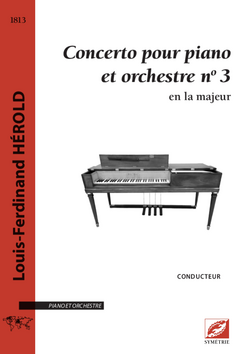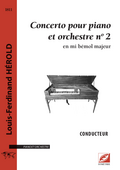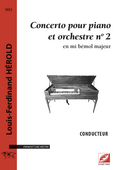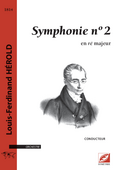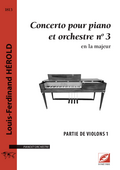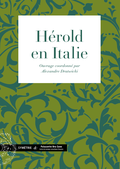Born in Paris on 28 January 1791, Ferdinand Hérold was the son of the composer and pianist François-Joseph Hérold, also his first piano teacher.
He further studied with the young Joseph Fétis before entering the Paris Conservatoire, where in 1810 he obtained a First Prize in piano by playing one of his compositions, a rare occurence. The following year Hérold joined the class of Étienne-Nicolas Méhul, who initiated him to his particular aesthetics of composition, more harmonic than melodic. The young composer won in 1812 the prestigious Prix de Rome with the cantata La Duchesse de La Vallière, and consequently stayed at the Villa Medicis in Rome. Health problems as well as a reform of the stay of the residents of the French Academy in Rome led him in 1813 to Naples where he wrote plenty of instrumental music, but also his first operas. Back in Paris in 1815, Herold became the pianist accompanist at the Théâtre-Italien, then the chorus master 9 years later, before joining the Académie royale de musique in 1827.
At the acme then of his art, Hérold died in Paris on 19 January 1833, leaving an important music production. Though his name is often associated with his works for the Opéra-Comique (Zampa, 1831 and Le Pré aux clercs, 1832), in his early years the composer showed “that he was a gifted and prolific composer of instrumental music too”: 4 piano concertos between 1810 and 1813, 2 symphonies (1813 and 1814) counting among his “Envois de Rome”4, 3 string quartets (1814). If for many Hérold “is the best representant [of the opéra-comique] during the years when romanticism is establishing in France”, his correspondance, during his Italian stay, testifies a late interest for the lyrical genre. In addition he wrote several ballets, among which La Fille mal gardée (The Wayward Daughter, 1828), now a standard of the choreographic repertoire.
Rediscovered at the end of the 2000s, Ferdinand Hérold was highly respected in his time by his peers. His works, influenced by Weber and the German music, are characterized by daring harmonies, a melodic elegance and a very good dramatic construction.
Publications
Format bibliographique à copier
Hérold, Louis-Ferdinand. Concerto pour piano et orchestre n°2, en mi bémol majeur, Symétrie, 2021.Hérold, Louis-Ferdinand. Concerto pour piano et orchestre n°2, en mi bémol majeur, Symétrie, 2021, 72 p.
Hérold, Louis-Ferdinand. Concerto pour piano et orchestre n°2, en mi bémol majeur, Symétrie, 2021, 36 p.
Hérold, Louis-Ferdinand. Concerto pour piano et orchestre n°2, en mi bémol majeur, Symétrie, 2021, 118 p.
Hérold, Louis-Ferdinand. Concerto pour piano et orchestre n°2, en mi bémol majeur, Symétrie, 2021, 120 p.
Hérold, Louis-Ferdinand. Concerto pour piano et orchestre n°3, en la majeur, Symétrie, 2021, 72 p.
Hérold, Louis-Ferdinand. Concerto pour piano et orchestre n°3, en la majeur, Symétrie, 2021, 72 p.
Hérold, Louis-Ferdinand. Concerto pour piano et orchestre n°3, en la majeur, Symétrie, 2021, 32 p.
Hérold, Louis-Ferdinand. Concerto pour piano et orchestre n°3, en la majeur, Symétrie, 2021, 56 p.
Hérold, Louis-Ferdinand. Symphonie n° 2, en ré majeur, Symétrie, 2018, 60 p.
Hérold, Louis-Ferdinand. Symphonie n° 2, en ré majeur, préface de Victor Monteragioni, Symétrie, 2017, 60 p.
Hérold, Louis-Ferdinand. Symphonie n° 2, en ré majeur, Symétrie, 2016.
Hérold, Louis-Ferdinand. Concerto pour piano et orchestre n°3, en la majeur, Symétrie, 2010.
Hérold, Louis-Ferdinand. « Premier voyage italien (1812-1815) », Hérold en Italie, coordination de Alexandre Dratwicki, Symétrie, 2009, p. 187-354.
Hérold, Louis-Ferdinand. « Second voyage italien (1821) », Hérold en Italie, coordination de Alexandre Dratwicki, Symétrie, 2009, p. 355-394.
Hérold, Louis-Ferdinand. « Lettres de jeunesse d’Hérold à sa mère et sa grand-mère (1803-1805) », Hérold en Italie, coordination de Alexandre Dratwicki, Symétrie, 2009, p. 397-400.
Hérold, Louis-Ferdinand. « Lettres tardives d’Hérold à sa mère (1818-1833) », Hérold en Italie, coordination de Alexandre Dratwicki, Symétrie, 2009, p. 401-408.





